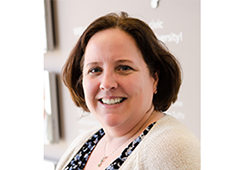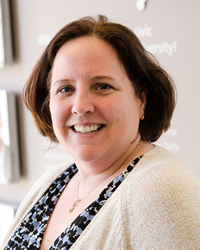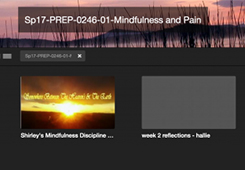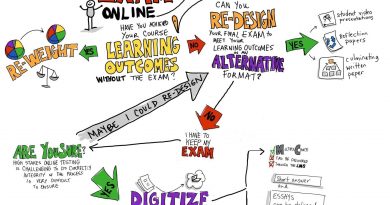
Making Connections: Teaching a Blended Course in the 1+4 Bridge Year Program
Felicia Sullivan is a Senior Researcher at Tisch College and the instructor of a full-year, blended course for participants in the 1+4 Bridge Year Service Learning Program.

Tell us more about the 1+4 Bridge Year Program and the course you are currently teaching.
“Communicating for Change” is a component of the larger 1+4 Bridge-Year Service Learning Program. This full-year, 1-credit course is only open to Tufts 1+4 Bridge Year participants and is taught through a blended learning format. With a focus on communicating the Bridge Year to others, students explore their Bridge Year service experience through related readings, investigative data collection, guided exploration of social issues, service placements and host communities, and reflections. Through a variety of communication exercises, faculty guidance and peer interaction, the course enhances the Bridge Year experience by creating a framework for students to make connections between the work they and their peers are doing both at the local and global level. Participants learn specific communication skills for translating social change experiences to a broader public. They consider how their Bridge Year experience connects to their future academic interests and possible impact on campus life once they return.
What are the main learning goals of “Communicating for Change”?
Ideally students will have the following learning outcomes from the class:
- Demonstrate critical thinking skills and gain a deeper awareness of social issues, their service organization and their host community through structured assignments.
- Make connections across placements and locations to consider the broader context of social issues and active citizenship efforts.
- Consider the impact of literature and written expression within social change movements and develop their writing skills for advocacy and social transformation.
How are you using technology to support those goals?
Students start the course with two class sessions that are part of their one-week orientation onsite on the Medford campus. During this week they are supplied with iPads from Educational Technology Services and get oriented to the online learning management system (Trunk). The course is separated into six learning modules, which are all available via Trunk. They complete 8 communication assignments that are supplemented by bi-weekly reflections and structured peer learning group interactions. Students are free to use their choice of tools (e.g. word processing, graphic design, audio, video) to complete assignments. Email, social media, blogs and messaging are the key tools used to communicate between students and with myself. Students wrap up their course with a class conducted during a post-Bridge Year retreat held on the Medford campus in the spring.
What is working?
I think creating structured but flexible assignments are allowing students to communicate their experiences in the program in a set of broad ways. Because each student needs to share their work with at least two other peers, both in different countries, students are also getting a sense of the wide variety of organizations and situations the other person is encountering. Some students are using blogs to communicate their experience, which has been very useful, and every student submits a post to the program’s public blog each semester. As we wrap up the fall semester, these public blogs have been useful for others to see a bit insight the program.
What needs improvement?
In terms of some things that are not working as planned, initially there were weekly reflections, which were proving to be very onerous and stressful to students. So given their feedback, I reduced those. Additionally, because the course is part of a much larger learning experience and because partner agencies have their own requirements to capture learning, I think there is a bit of a struggle to keep this course present in the minds of the student. With that said, students are keeping pace with the assignments and keeping communication open, which are key. I also need to provide more feedback regarding peer-learning groups to ensure that students get the most out of the course. Because I have continual feedback built into the course, I am able to make these adjustments relatively quickly.
I had originally planned on integrating a tool called VoiceThread which creates a bit more presence and embodiment in the online course environment by allowing for threaded video posts. We didn’t have adequate time to troubleshoot that technology. I want to work out the kinks with VoiceThread — I use it in other online classes to great effect and I am certain it would add much to the experience for the 1+4 participants.
What will you do differently next time?
Given that the second half of the course will take place over the spring semester, there is still much to learn about how to structure the course differently. I also want to require the use of student blogs in the hopes of allowing students to have a central place for all of their reflection. Part of the challenge here are the diverse program environments students are in. Some have their own blogs already, some of the 1+4 partner organizations require blogs, and some students don’t want to put their work in a central place. Therefore, the next challenge will be thinking through how we can meld different options together in a way that makes sense. I also need to debrief with the students in the spring to see what they recommend from their own perspective on how the course went. Their feedback will also provide some expert insight into what can be modified moving forward.
Interview has been edited and condensed.



